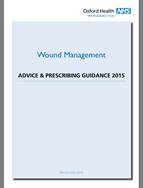Wounds
Assessment is the foundation of all clinical practice; without a robust holistic assessment it is difficult to achieve a clear management plan. This section provides information and tools to aid clinicians in clinical practice and to support them to develop clear and achievable management plans.
The following guidelines are available to assist clinicians:
Wound prevention, assessment & management
We advocate the use of TIME principles to provide a systematic approach to the assessment and management of wounds. TIME is based on assessment and intervention in four clinical areas with the aim of producing a well vascularised wound bed that facilitates the effectiveness of other therapeutic measures.
The objectives underpinning TIME are:
- T – Tissue – assess for and treat any non-viable or deficient tissue
- I – Infection or Inflammation – identify and treat
- M– Moisture Imbalance – restore balance
- E – Epidermal Margin non advancing or undermined – identify and optimize wound edges
This framework should be used in addition to obtaining a complete and in-depth medical history and discussion with the patient (and relatives/NOK if appropriate). Regular assessment and review of wound surface area, depth and undermining are also crucial when formulating a management plan. Wound photography is an invaluable tool to monitor progress or deterioration in the wound. Wound photography and mapping are both also fantastic tools in encouraging active participation with patients and can provide a real boost to patient morale.
The following tools and documents are available to assist clinicians and can be found under the resources Tab:
- Abbey pain scale progress sheet

- AMBLE Tool – Assessment/management of bacterial loading in wounds
- Calculating wound surface area/size reduction
- Leg ulcer assessment form
- Lower limb assessment form
- Pain assessment and management leaflet
- Pathway for the treatment of skin that is damaged and excoriated by moisture
- Potassium Permanganate Procedure
- Protocol for the use of Topical Steroids in Wound Care
- Removal of foam dressings
- Wound assessment and evaluation form
- Wound healing pathway/risk tool
Wound Infection and Biofilm
Oxfordshire Wound Management Formulary

It is important that within the NHS we are able to justify our clinical decisions and expenditure on wound management products. In Oxfordshire we currently spend £1.8 million annually on dressings, bandages and tapes; therefore the wound management formulary has been developed with the explicit aims of:
- Promoting evidence based practice by providing a framework within which it is safe to practice
- Promoting continuity of care
- Promoting rational prescribing
- Encouraging safe, effective and appropriate use of dressings
- Promoting cost effectiveness
Product selection should be based upon a comprehensive and holistic assessment of the patient and their wound. Once the wound aetiology and the intended treatment outcome have been confirmed, an appropriate product can be selected. If a patients wound fails to progress as expected then a referral to tissue viability should be considered.
Skin Tears
 Skin tears are acute, traumatic wounds caused by the mechanical forces of shear, friction or trauma, including the removal of adhesives, resulting in a partial or complete separation of the outer skin layers from the inner tissue (ISTAP, 2018). They can occur anywhere on the body but are most commonly seen on the hands, arms and lower legs. 70–80% of skin tears occur on hands or arms. Skin tears can be painful and distressing for the patient.
Skin tears are acute, traumatic wounds caused by the mechanical forces of shear, friction or trauma, including the removal of adhesives, resulting in a partial or complete separation of the outer skin layers from the inner tissue (ISTAP, 2018). They can occur anywhere on the body but are most commonly seen on the hands, arms and lower legs. 70–80% of skin tears occur on hands or arms. Skin tears can be painful and distressing for the patient.
It is estimated that prevalence of skin tears may be underreported and in fact be greater than pressure ulcers. To date, no prevalence data is available for the UK, so the cost to patients and the NHS is not fully known. The ageing population means that incidence of skin tears is increasing (elderly patients have fragile skin and are at increased risk)
Skin must be protected in at-risk patients and skin tears managed to avoid further damage and prevent progression from an acute to a more chronic, potentially hard to heal wound.
- Skin Tear Pathway (with stock list)
- Skin Tear Pathway Training Presentation
- Skin Tear Pathway Training video is available on YouTube on the Tissue Viability training playlist
Management of skin tears in residential homes
The following resources are available to support Care Leaders in Residential Homes in providing 1st Aid to a skin tear:
Burns
Haematomas
VAC therapy
Negative Pressure Wound Therapy (NPWT) is the use of controlled suction to promote healing. ‘VAC’ is often used generically to denote NPWT, and means ‘Vacuum assisted closure.’ NPWT is helpful for promoting healing in circumstances where tissue perfusion is compromised, and also in some cases where excessive exudate cannot be controlled by other means.
NPWT involves applying a suction force (i.e. vacuum) across a sealed wound, using a reticulated foam interface or specified types of gauze. Both the suction effect and the mechanical forces generated at the interface with the wound lead to a variety of changes in the wound, positively influencing the healing process.
Please follow the links below for further information and guidance.
- Acute to Community VAC Discharge Process
- VAC counting in and out document
- Protocol for the use of Negative Pressure Wound Therapy (NPWT) in the community
- ActiVAC User Manual
- VAC Therapy Competency Framework
- VAC Therapy – Basic Dressing Application Guide
- VAC Therapy – Patient Information Booklet
- VAC – Picture Framing Liner
- ActiVAC Trouble Shooting Guide
- VAC Training Videos Resources
Page last reviewed: 4 March, 2025
